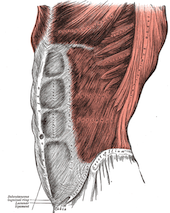External Abdominal Oblique
Original Editor - Khloud Shreif
Top Contributors - Khloud Shreif, Lucinda hampton, Joao Costa and Kim Jackson
Description[edit | edit source]
External abdominal oblique (EO) is a flat superficial abdominal muscle located on the lateral side, with anterior abdominal muscle forms anterolateral abdominal wall. Its fibers directed inferiorly and medially, its fibers overlap with other abdominal muscles; transverse abdominals, and internal obliques that help support the abdominal wall and decrease the risk of abdominal herniation.
Origin[edit | edit source]
It originates from the external surface of the lower eight ribs 5-12.
Insertion[edit | edit source]
The most posterior fibers directed vertically and other fibers anteromedially.
The EO continues as an aponeurosis at midclavicular line superior and spinoumblical line inferiority, by which inserts into the linea alba, the anterior half of iliac crest and the pubic tubercle.
Nerve[edit | edit source]
The upper two-third of external abdominal oblique supplied by lower intercostal nerves T7-T11 and subcostal nerve T12.
The lower third supplied by the iliohypogastricL1 from lumbar plexus.
Artery[edit | edit source]
Upper 2/3 receives blood supply from branches of lower posterior intercostal and subcostal arteries, lower 1/3 from deep circumflex iliac artery.
Function[edit | edit source]
Bilateral contraction of EO along with rectus abdominis and internal oblique flexes the trunk by drawing the pubis towards the xiphoid.
Unilateral action: ipsilateral side flexion and contralateral trunk rotation
External abdominal oblique muscle with other abdominal muscles helps to maintain abdominal tension and support abdominal viscera, increase intraabdominal pressure that is helpful in forceful expiration, coughing, defecation.[1]
Clinical Relevance[edit | edit source]
Weakness of EO muscle with other abdominal muscles increases the risk of hernia, umbilical hernia for example.[2]
Bilateral muscle weakness decreases the ability of trunk flexion, and you can see anterior pelvic tilting from standing position in cases of bilateral weakness.
Trigger points: abdominal obliques may develop trigger points due to emotional stress, extra load during exercises, or even new exercise, due to incision, direct trauma, or secondary due to other visceral pathology. The most common sites for obliques trigger points:
- Lateral lower quadrant of the abdominal wall near to ASIS and refer pain diagonally across the abdomen, groin and genitalia.
- Below and lateral to the xyphoid process of the sternum with few inches refer pain to lower chest and upper abdomen, this pain can be mistaken by heartburn[3].
Assessment[edit | edit source]
References[edit | edit source]
- ↑ https://www.kenhub.com/en/library/anatomy/external-abdominal-oblique-muscle
- ↑ Flynn W, Vickerton P. Anatomy, Abdomen and Pelvis, Abdominal Wall. InStatPearls [Internet] 2019 Dec 9. StatPearls Publishing.
- ↑ https://www.bluegrassdoctorspt.com/apps/blog/show/42868752
- ↑ Niel Asher Education. Trigger Point Release Therapy - The Obliques. Available from: https://www.youtube.com/watch?v=_WoYZ6-1CqU[last accessed 2/5/2020]
- ↑ MMT Manual muscle test internal and external obliques Dr. Bryan - Physical Therapist.. Available from: https://www.youtube.com/watch?v=KAX_CT98yKs[last accessed 2/5/2020]







